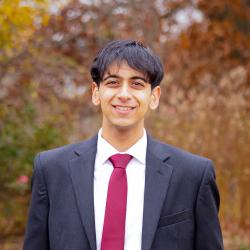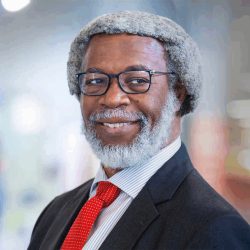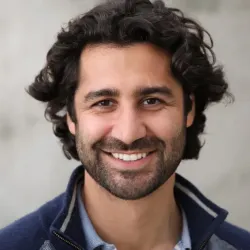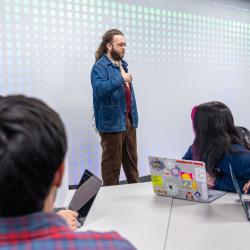2015: A Quantum Odyssey
There is an apparition in the basement of the university’s Computer and Space Sciences building.
It is not an apparition in the supernatural sense, or in the Harry Potter novels’ sense of teleportation, though that notion is not so far from reality. Rather, the apparition is the unexpected appearance of a transformational invention with the power to change the world.
Many scientists think society is on the brink of a second information age, thanks to a new field known as quantum information, sprung from the marriage of quantum physics and theoretical mathematics. The invention that could usher in this second information age is a quantum computer.
“Quantum computers will be able to solve some problems dramatically faster than today’s computers and solve difficult problems that are not solvable today,” says Jayanth Banavar, dean of the University of Maryland’s College of Computer, Mathematical, and Natural Sciences and a physics professor. “They will change our lives in ways that we cannot even imagine.”
“A quantum computer is the holy grail of quantum science,” adds UMD Physics Professor Steve Rolston, who co-directs the Joint Quantum Institute (JQI), a research partnership between UMD and the National Institute of Standards and Technology, with the support and participation of the Laboratory for Physical Sciences.
Because of the quantum computer’s potential to alter the field dramatically, scientists are researching every possible application of quantum information—communication networks that cannot be tapped; small, powerful sensors with more uses than we can currently guess; and materials with strange and potentially useful properties. The researchers’ goal is to understand how quantum mechanics can store, process and transmit information faster, better and more securely than today’s technology.
Quantum possibilities
The race is on to build the first quantum computer. Right now, the device in the basement of the Computer and Space Sciences building is a leader in the field. This futuristic machine is fundamentally different than any computer on the market today.
A typical computer stores information in bits—individual digits, all of them either 0s or 1s. A laptop with one gigabyte of memory can store 8 billion 0s or 1s. A computer scientist would describe that memory as 8 x 109 bits. But a quantum computer takes advantage of the unseen properties of what physicists call “the quantum realm”—typically, the world of atoms and subatomic particles, things too small to be seen with the naked eye. In this world, a quantum bit—or qubit—can be a 0, a 1 or both at the same time. That means a single qubit could give a quantum computer’s operating system the capacity to do two calculations at once. And unlike a laptop, which adds computing power in a linear way as more bits are added, a quantum computer grows exponentially. A program using two qubits can do four calculations at once (22), one using three qubits can do eight (23) and so on. A quantum computer with 300 qubits could represent vastly more information than a conventional computer, 2300 or about 1090 numbers.
“That is more than the number of particles in the universe,” says Christopher Monroe, Bice Zorn Professor of Physics and a JQI fellow (a title given to research scientists on the institute’s permanent staff). “A quantum computer that big could deal with massive amounts of data in a way nothing else can.”
Monroe intends to build that quantum computer. The apparition in the basement of the Computer and Space Sciences building is his device—an array of lasers, lenses, mirrors, optical cables, cameras and steel boxes laid out on a table the size of a two-car garage door. At its heart is a vacuum chamber with 20 electrically charged ytterbium atoms held in a bowl made of electromagnetic fields and kept in a quantum state of multiple possibilities.
At 20 qubits, Monroe’s creation is among the largest quantum computing devices in the world. (A company in Canada has built a 512-bit machine, but experts question whether it is a true quantum computer, and test results are contradictory.) Monroe, who has been working in the quantum science field for 20 years, plans to build a 50-qubit device in the next year or two. His sights are set on eventually building a 100-qubit device, which has the potential to do calculations so advanced that no conventional computer could even double-check them.
"No other place has the breadth that we have"
Physicists worldwide have developed a handful of different design strategies for a quantum computer, many of which are being advanced by work at UMD. In fact, UMD boasts top innovators in three of the approaches, as well as researchers working on hybrid approaches and young experimentalists who are about to launch new strategies.
Together, UMD’s quantum scientists have as much collective knowledge as their peers at any university in the world and more versatility than at any other research center, says Sankar Das Sarma, a Distinguished University Professor who holds the Richard E. Prange Chair in Physics at UMD.
“No other place has the breadth that we have,” says Das Sarma, a quantum theorist who developed the concepts underlying two of the design strategies. “The University of Maryland really is number one in quantum science.” He cites two important reasons. “The university and the college have been extremely supportive of quantum science, and the JQI has become much more than the sum of its parts.”
Spooky action at a distance
Rolston, JQI’s co-director, divides quantum science into two phases. The first quantum revolution began in the early 20th century and involved new insights into the way materials behave at the microscopic level. “The information revolution is all about understanding materials through quantum mechanics and designing devices based on that,” he says. “It is transistors, magnetic storage and the laser. That’s the straightforward part of quantum mechanics.
“There is a second part of quantum mechanics that we call ‘quantum weirdness,’ these wonderful, counterintuitive things that used to be simply interesting oddities without much relevance,” Rolston says. “But in the last 20 years, as we have become very good at manipulating individual atoms, we can now exploit some of these oddities to do new things.”
To understand one important quantum oddity, you must forget the notion of opposites. In the quantum realm there is no duality, no yes-no, no on-off. Everything can exist in more than one state. An electron can spin clockwise and counterclockwise at the same time. A flipped quantum coin lands simultaneously on heads and tails. And if you hand a quantum physicist a sealed box and tell her the ball inside is either red or blue, she will set you straight: the ball is both red and blue. This capacity to be two things at once is called “superposition,” and it is the key to quantum systems’ extraordinary flexibility.
Furthermore, in the quantum world, two objects can behave in ways that are correlated, even though they have never been in contact. Physicists call this “entanglement.”
“If you flip two coins, there are four possible outcomes—heads and heads, tails and tails, heads and tails, and tails and heads,” explains David Hucul, a Ph.D. student in Monroe’s lab. “If the two quarters are entangled, they are correlated in specific ways. Let’s say, for example, the quarters are always correlated. Every time one quarter shows heads, the other quarter also shows heads. If you took one quarter and I took the other, you could fly to California and flip your coin. The result would be random, just like any other coin toss. But if it came up heads, you would immediately know that my coin also came up heads. And if you got tails, you would know instantly I got tails, even if I was on the other side of the universe.”
This seems impossible, Rolston points out, because information cannot be transmitted faster than the speed of light. But with quantum objects, the correlation is as close to instantaneous as anyone can measure. And from this simple starting point—a scrap of information shared by means of entanglement—researchers can move on to develop codes, communication networks and
computation tools.
In the 1930s, Albert Einstein called the phenomenon of entanglement “spooky action at a distance.” Rolston believes it is only spooky if you are wedded to the notion of objective reality. “The really fundamental bizarre thing about quantum mechanics is that it is really not a theory about nature,” he says, “but about our knowledge of nature. In other words, there is no objective reality.”
Consider that ball in the box: it can be red, blue and simultaneously red and blue. Its real state may not only be unknown, but undetermined until the physicist opens the box and observes the color. This is quantum indeterminacy, the idea that a quantum object may have no fixed properties until the object is observed and measured.
“Whenever I measure something I disturb it. I cannot precisely measure both position and velocity of a particle, for instance,” says Rolston. “The more carefully I measure the particle’s velocity, the less certainty I have about its position.”
Conundrums like this are both the strength and the weakness of quantum science. For example, because any measurement of quantum data is disruptive, it would be almost impossible to hack into a quantum computer or intercept communications on a quantum network without being detected. Anyone who reads a quantum message and then forwards it on to its destination would add so many errors that the interception would be noticed.
Because such a network would be much more spy-proof than today’s communications systems, the U.S. Army Research Laboratory is collaborating with the JQI to test the technology by building a fiber-optic quantum link between the campus and the lab’s headquarters in Adelphi, Md.
At the same time, Monroe points out, quantum uncertainty makes it hard to pause a quantum computer and confirm it is working because any measurement of the computer’s qubits will alter the results. Not to mention the fact that quantum states are extremely fragile.
Quantum bits must be kept cold, as close to absolute zero (-273.15 degrees Celsius, -459.67 degrees Fahrenheit) as possible. A few molecules of air in the vacuum chamber that houses them, a thud that shakes the laboratory floor or an electrical surge in the room’s wiring can cause qubits to “decohere,” or slip out of superposition and become either a 0 or a 1, and thus no better than a conventional bit. In most experiments, the qubits remain in their quantum state for just a fraction of a second.
There is no question that researchers face some big challenges. They must find a way to keep qubits securely confined and reliably quantum, yet still accessible and controllable. Because they know quite a few qubits will slip out of the quantum state, they have to build in a hefty surplus to compensate. And they have to entangle the qubits in an efficient pattern so the computer will be fast, versatile, fail-safe and will continue working even if most qubits decohere.
"At some point you have to make that leap"
With so many problems to solve, it is no wonder UMD researchers are trying several different strategies.
In Monroe’s laboratory, researchers heat the rare earth element ytterbium to convert it to a gas, then inject a few neutral atoms of the gas into a vacuum chamber. A laser beam strips an electron from each atom, converting them to positively charged ions. A second laser beam chills them to a few thousandths of a degree above absolute zero. Inside a gold and ceramic chip designed and built in the lab, electric fields of varying strengths and directions hold the ions still in a crystalline pattern about a tenth of a millimeter wide. Once the ions are trapped in place, the scientists use specially tuned lasers to connect them into a miniature circuit similar to those in conventional computers.
The same principles are guiding work across the hall in another of Monroe’s experiments, where graduate student Hucul tracks the action in two separate vacuum chambers a meter apart. Each chamber holds a single ytterbium atom and has its own Rube Goldberg array of lasers, lenses and mirrors designed to beam a photon—a particle of light—precisely enough to hit that one ytterbium atom. Next, the two photons travel through optical cables to a beam splitter, which they strike simultaneously.
At the moment the beam splitter detects them, the two ytterbium atoms—which are still in separate vacuum chambers a meter apart—become entangled by light. Measure the way one of them spins, and researchers will instantly know which way the other one spins.
“We think this is a good architecture for a quantum computer, because a big quantum system is going to have to be modular,” says Monroe. “You can keep putting more qubits on a chip, but at some point you run out of space or run into noise and you have to make that leap and link a lot of chips together.”
Many quantum computing experts think Monroe’s approach is the most advanced and will be the easiest to scale up quickly. It has even attracted financial support and engineering expertise from Lockheed Martin, the Bethesda, Md.-based global security and aerospace company with a 60-year history of support for UMD research. (See “Partnerships Empower Quantum Leaps.”)
Quantum doughnuts
Other strategies seek to work around the delicacy of the quantum state by using materials that are potentially less sensitive to the environment. In fact, Das Sarma’s ideas have inspired some of these alternative approaches.
Das Sarma and other quantum theorists use mathematics and abstract reasoning to explain the behavior of solids, liquids, superconductors and atomic phenomena that happen only in the quantum realm. In his 34 years at UMD, Das Sarma has been responsible for many breakthroughs in quantum research, including the conceptual basis for artificial atoms made from semiconducting materials, called “quantum dots,” which could be used in a quantum computer. But these days, he is most excited by an approach based on what he and others call “quantum doughnuts.”
Imagine any circular shape with a hole in the middle, such as a doughnut or rubber teething ring. Bite around the edges of a doughnut and it remains a ring. Twist a baby’s teething ring and the ring keeps its original shape.
Researchers who specialize in topology—the study of these resilient shapes—think they are ideal for building quantum computers. A design that encodes information in this shape could overcome the fragility of quantum superpositions because a ring is still a ring no matter how you deform it. Rings of qubits could be braided together into circuits that would keep working even if many of the qubits decohered.
In 2005, Das Sarma collaborated with a Microsoft physicist and several other colleagues to introduce the concept of the braided topological qubit. Five years later, Das Sarma and colleagues proposed that by layering certain superconducting metals like a sandwich, researchers could create special particles, called Majorana fermions, which could act as qubits in a topological quantum computer. Preliminary proof-of-principle studies show these qubits can be made in lab conditions that are not as exacting as the ones needed for Monroe’s ion trap design.
“You need low temperatures, but not anywhere near as low as other approaches, and a much lower magnetic field,” says Das Sarma. “We call this ‘generic topological computing,’ because it’s relatively easy to do.” The next step is for experimentalists to build a prototype that links some Majorana fermions together to function as qubits.
One of JQI’s newest scientists plans to do that. But first, Vladimir Manucharyan is setting up a laboratory in the new Physical Sciences Complex, where he plans to take an entirely different approach to quantum computing. Born in Azerbaijan and educated at Moscow Technological Institute and Yale University, Manucharyan joined JQI and the Department of Physics as an assistant professor in January.
Where Monroe captures individual atoms, holds them in that strange multiple-identity quantum state and connects them together, Manucharyan’s approach draws on ideas from electrical engineering. He builds precise electronic circuits that use a special type of quantum transistor. But otherwise, he explains, “they work just like a regular circuit from Radio Shack.” He chills the circuits to nearly absolute zero in a special $500,000 refrigerator imported from Finland. The ultracold circuits are superconductors, carrying an electrical current in perpetuity without generating any heat. Manucharyan says these circuits can be manipulated into behaving like networks of qubits with the same characteristics as Monroe’s trapped atoms.
The superconducting electronic circuits Manucharyan builds do not lose energy, so they are more stable. The circuits are bigger than the single atoms in Monroe’s ion traps, but they are still difficult to build, link together and get into a quantum state.
Manucharyan likes the fact that experts in other quantum systems are a few doors down the hall, because it makes brainstorming with colleagues much easier. “We hope to learn what Chris does with his ions, and vice versa,” Manucharyan says. “To have more than one approach in the same department is very, very helpful.”
Manucharyan plans to launch another experiment with Das Sarma’s Majorana fermions next year. “I find this approach fascinating because it involves fundamental questions of physics and new states of matter,” Manucharyan says. “It requires a lot of technical skills, but I think we can actually make it work.”
Asking the questions that really matter
Eventually, in 10 or 20 or 50 years, the first quantum computer will become a reality. Then what?
“Right now, there is a limited set of things that we know we can do easily through quantum mechanics that we cannot do easily with a classical computer,” says JQI Fellow Jacob Taylor, a NIST physicist who specializes in quantum information theory.
Some of the advantages are well studied and widely accepted. For example, a quantum computer can find the factors of a large number exponentially faster than a classical computer. That could render existing technology for online commerce obsolete, because today’s most widely used encryption technology is based on the difficulty of factoring long numbers. “If everybody has a quantum computer, the current encryption technology is no longer secure,” says Taylor.
Researchers agree a quantum computer will quickly find patterns within huge databases that are too big to search with existing computers. In the “big data” age, when all sorts of personal information is archived, that could be a major boon to many fields, such as medical research. A quantum computer could help chemists develop complex new medicines made up of hundreds of molecules, says Rolston. And in game theory, a quantum computer could identify the pivotal points on a decision tree, or “the few questions that really matter, while the rest are irrelevant,” explains Taylor.
But the new machines will likely be error-prone and vulnerable to hacking. “Almost always, the weakest link in any system is a person whose credentials have been compromised,” Taylor says. “That is not going to change. So you have to look at the computer’s overall infrastructure and ask which parts of it are going to be broken and which parts of it can be fixed.”
In October 2014, Taylor, UMD Distinguished University Professor Emerita in Computer Science Dianne O’Leary, and colleagues at the university’s Institute for Advanced Computer Studies established the Joint Center for Quantum Information and Computer Science (QuICS), a partnership between the University of Maryland and the National Institute of Standards and Technology, with the support and participation of the Research Directorate of the National Security Agency/Central Security Service. Taylor is co-directing the center with Computer Science Associate Professor Andrew Childs. In QuICS, quantum theorists will explore these questions and many more.
QuICS researchers aim to answer questions that fall into four categories: How does our knowledge of quantum mechanics change our understanding of what computers can do? How does our knowledge of the capacity of quantum computers change our understanding of nature? How can a technological society keep its information secure in a quantum world? And finally, given all the imperfections and challenges of quantum computing, how do we go forward into the second information revolution?
As if those questions were not enough to think about, Taylor is also working to understand quantum systems and sensors. He is collaborating with other researchers at NIST and UMD to develop quantum magnetic sensors for use in biological assays and a quantum device that precisely measures gravitational fields. Such a sensor could guide airplanes from takeoff to landing if GPS systems fail, and find oil underground or submarines beneath the ocean’s surface.
A new invention, a new understanding
The race to create a quantum computer is just beginning. “A demonstration in the lab is maybe 10 years away,” says Das Sarma. “A marketable quantum computer is probably 25 to 30 years away.”
Meanwhile, the college’s work is contributing to both basic and applied science in much the same way the Apollo space program did in the 1960s.
“We are really coming to understand quantum mechanics at the macroscopic level,” Das Sarma says. “How do quantum states disappear? What do you have to do to keep quantum states alive forever? How can we see quantum behavior in thousands or millions of atoms simultaneously? All of these are big questions that lead to a quantum computer, and they lead to an understanding of nature too.”
Dean Jayanth Banavar agrees, noting that this research will ultimately benefit humankind. “This will not be an evolutionary change, but a revolutionary change. We are poised to create the next revolution here at the University of Maryland, and the future is going to be breathtakingly exciting.”
Writer: Heather Dewar







